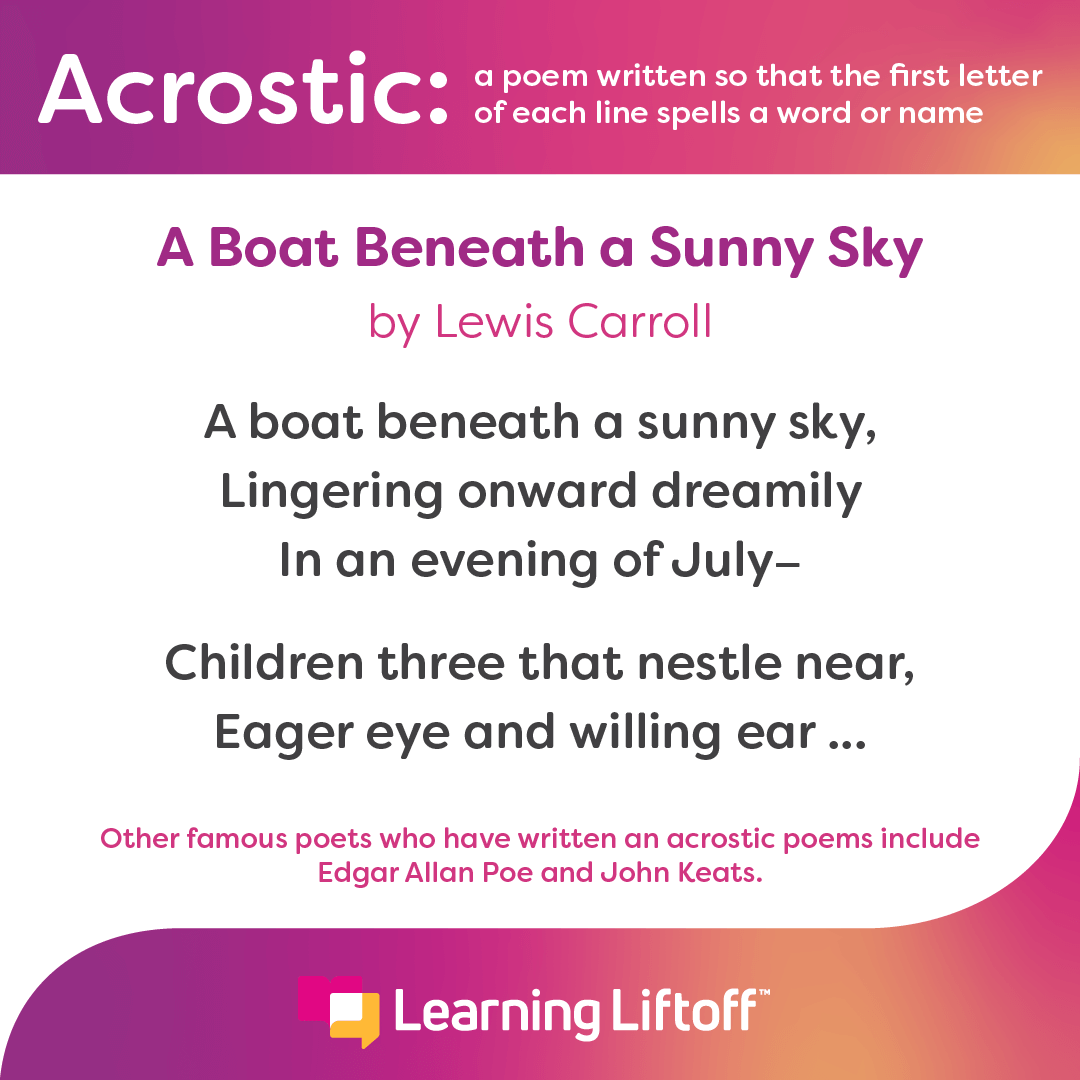Summary: Explore different types of poems for kids and learn helpful tips and tricks for teaching poetry at home or in the classroom.
The rich history of poetry reaches back through centuries, even preceding the written word. While its origins remain unclear, historians believe that some its earliest forms included ritualistic recitations used to ensure ample harvests and poetic notations of historical events passed down in ancient civilizations, such as Egypt, Babylon, and China. Deriving from the Greek word poieo, meaning “I create,” poetry offers a form of self-expression that’s oftentimes more stirring than standard prose. Throughout history, poetry has transformed and found many uses, conveying many emotions and feelings including love, hate, anger, and sadness, through prayer, stories, art, music, and even nursery rhymes.
Today, poetry remains a powerful tool and outlet for creative expression, providing students with a unique way to learn more about language, including vocabulary, reading comprehension, phonemic awareness, and literary devices. It can also inspire creativity, empathy, and an interest in writing.
Overcoming Challenges of Teaching Poetry
And yet, many teachers have expressed that teaching poetry can pose a challenge due to students’ apprehension and disinterest. In fact, one study found that students encountered poetry with the expectation that it would be a difficult subject and they would likely fail at it. Other teachers have shared that their students expressed that poetry is too abstract, cryptic, hard, and emotional and forces them to face topics they would rather avoid altogether, such as death. But with the right approach, teachers and parents can help students understand the relevance and appreciate the art of poetry.
Following these steps can help students feel more relaxed as they learn about poetry and, perhaps, inspire a new generation of poets:
- Discuss how to read a poem for meaning: When students read a poem quickly, the meaning is likely to be overlooked. A K12 English Language Arts teacher shared that students can better focus on the meaning of a poem when they take the time to read it multiple times. Practice this with your students by encouraging them to read a poem aloud five times, as slowly as they can, and look up any word they might not know.
- Help them find a way to relate: It’s easy for students to think of Shakespeare and other textbook-provided poems and feel like they hold no value in their own lives—I remember feeling this way in school. Yet, our music playlists contain endless poetic verses. A University of Iowa teacher suggests having students pick a song off their own playlist and look for poetic devices within the lyrics, such as metaphor, simile, and rhyme.
- Create a safe space for interpretation: Students may feel vulnerable sharing their interpretation of a poem or the emotions it evokes. Reassure the students that their thoughts have value and will be respected.
- Inspire students to write their own poetry: Tatyana White-Jenkins, a K12 employee and published poet, shared that you can help students find inspiration for writing their own poetry by recreating a poem’s rhyme scheme, or pattern. For example, “Twinkle, Twinkle, little star, How I wonder what you are,” follows an AABB rhyme scheme, meaning lines one and two rhyme, while lines three and four rhyme.
Different Types of Poetry to Explore in the Classroom
There are many forms of poetry, but these common types of poems for kids can be a great starting point for introducing this creative genre:
Free verse
As the name implies, free verse affords the writer a lot of creative freedom in composition. These poems closely align with the natural rhythm and structure of speech, as they are non-metrical, do not need to rhyme, and can have as many lines as the poet desires.

Haiku
This ancient form of Japanese poetry follows a very specific structure containing three lines. The first and third lines have just five syllables, and the second line contains seven syllables. Learning about haiku can help students expand their vocabulary by exploring new words that are descriptive and concise.

Limerick
A limerick is a humorous, light-verse poem, comprised of five lines following an AABBA poetic scheme. Often used to tell a short tale or provide a description, these short rhymes can be a helpful tool for recalling information and memorizing facts.

Sonnet
Derived from the Italian word sonetto, or “little song,” a sonnet is a 14-line poem that traditionally follows iambic pentameter—which means each line contains five sets of stressed syllables and unstressed syllables. These types of poems are often about desire and romantic love and end with a volta, also known as a twist or turn, in which the subject suddenly changes, often providing a solution or answer to a topic established at the beginning of the poem.

Ode
An ode is a short lyric poem that is believed to have originated in ancient Greece. While odes were originally written to celebrate athletic victories and were often performed with a musical instrument, modern odes are used to praise a person, thing, place, or event. There are different types of odes, varying in meter, rhyme scheme, and length, but most commonly, odes consist of three to five stanzas with ten lines each.

Acrostic
This unique style of poetry is often used to introduce students to the art of writing poems. In an acrostic poem, the first letter of each line spells out a word, name, or message that aligns with the poem’s topic.

What’s wonderful about poetry is that there is something for everyone. So, if your students like comedy, romance, drama, or suspense—there is poetry that fits their preferences. The most important thing to remember is to help your students feel comfortable and safe when sharing their thoughts and feelings as they practice reading and interpreting poetry. They may even help you see familiar poems in a new light!
To learn more about K12-powered online schools, go to K12.com.





























































































